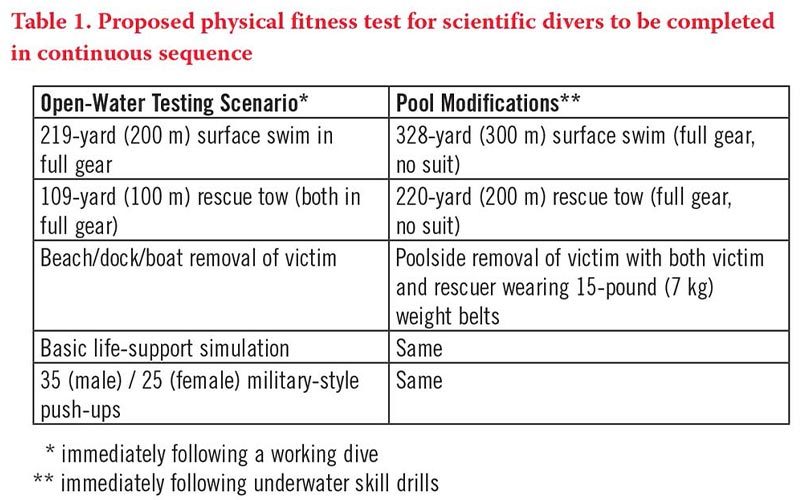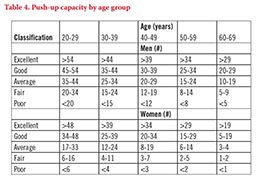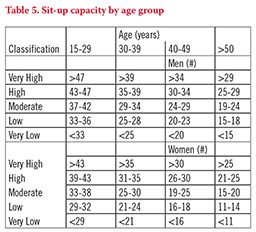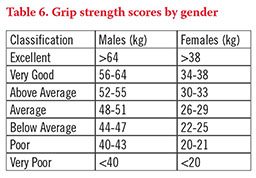The physical fitness requirements for diving depend on a number of factors. While this makes establishing a single standard challenging, it can also lead to interesting discussion.
At the most basic level, divers need to be able to easily meet the normal demands of diving with a fitness reserve sufficient to meet the additional demands of emergency situations. Environmental conditions dramatically influence “normal demands.” Calm, warm tropical waters are generally much less taxing than colder water. The demands increase as equipment, sea state, and entry and exit conditions intensify.
Diver skill also plays an important role in determining the demands of a dive. A diver with excellent buoyancy control wearing minimum ballast weight will work far less than a diver fighting improper weighting or having less refined buoyancy control.
Similar issues exist in establishing reasonable physical fitness buffers to handle emergency demands. Environmental conditions, equipment worn, proximity to a safe exit, available surface support and even the buddy’s physical fitness, size and skill have influence.
While the highest level of physical fitness is desired, a practical approach is to consider minimal competencies.
How to Evaluate Physical Fitness
A review of health history may be sufficient for healthy, active individuals. Functional fitness tests help ensure that a person is fit for diving. These can often be conducted in a pool or in open water. Lab-based tests of physical capacity may be appropriate in the case of a poor history of physical activity, concerns about safety during performance tests, or the presence of potential medical issues.
Functional Fitness Testing
Functional fitness testing has natural relevance to real-world activity. One simple series was proposed to evaluate recreational divers.1 Divers would demonstrate the following capabilities: 1) lift and carry individual items of diving equipment on land; 2) stand from sitting and walk 100 feet in standard scuba equipment; 3) ascend a 5-foot vertical ladder from the water wearing standard scuba equipment; and 4) swim underwater at 0.5 knot for 30 minutes and at 1.2 knots for 3 minutes wearing standard scuba gear.
Another approach was proposed for scientific divers, focusing on rescue capabilities.2 Evaluations followed a normal dive to start with typical fatigue levels. Since open-water environments are not available year-round in all places, a pool modification was also provided.
The details can be seen in Table 1.

Translating Functional Fitness Test Results
Aerobic capacity (VO2 max) is defined as the maximum amount of oxygen that can be consumed per unit of time. This is classically determined with a continuous, progressive exercise test to exhaustion. While too involved for general use, VO2 max is a standard for referencing overall fitness. The complicated units of milliliters of oxygen consumed per kilogram body mass per minute (mL/[kg·min-1]) can be simplified by converting VO2 max values into metabolic equivalents (METs). METmax is determined by indexing VO2 max to resting oxygen consumption (assumed to be 3.5 mL·kg-1·min-1, or 1 MET). The higher the MET score, the higher the aerobic fitness. An example of the conversion follows:
MET capacity (METmax) = VO2 max (in mL·kg-1·min-1) ÷ 3.5
e.g., 49 mL·kg-1·min-1 (VO2 max) ÷ 3.5 = 14 METs
A diver with good buoyancy control should work little during a typical dive. A skilled diver swimming at no more than 0.5 knot could be working at around 3 METs. A diver maintaining a pace of 1.2 knots could be working in the 10-12 MET range. We inferred workrate from open-circuit gas consumption during 959 recreational dives and conservatively estimated a mean workrate of 5 METs.3
Getting Fit for Diving
The key to being physically fit to dive is to find a way to stay active. The goal is to build or maintain reserves to delay the point at which activity patterns have to decline. Optimally, divers will be significantly physically active daily and bolster this with 30-60 minutes of training-quality activity three to four times per week. A mix of activities is generally best to reduce the risk of injury and boredom. (For suggested exercises, read our Dive Fitness articles in each issue or online at AlertDiver.com.)
Physical training should target three key elements: strength, aerobic capacity and flexibility. Low-impact activities reduce the risk of injury, and activities that involve water provide the added benefit of improving comfort in the diving medium.
Field Measures of Physical Fitness
We conduct field evaluations of diver physical fitness as part of many of our research studies. We record a variety of measures to provide a snapshot for participants, often motivating them to improve their numbers.
Body Mass Index (BMI)

Body mass index (BMI) is not a measure of body composition; it is simply a ratio of weight to height (weight in kilograms divided by squared height in meters). Despite this, BMI is used to predict body composition since it is more common for an increase to reflect an accumulation of fat than lean tissue. While convenient, BMI can provide a poor estimate on an individual basis, requiring common sense for interpretation. With this caution in mind, those with BMI values outside the desirable range should have their body composition evaluated further. If a high BMI is the result of excess fat, lifestyle changes that incorporate additional exercise and dietary changes are recommended.
Waist-to-Hip Ratio (WHR)

A high waist-to-hip ratio (WHR) — i.e., having high girth in the midsection — may indicate an increased risk of developing heart disease. WHR standards are age-dependent (see Table 3). Ratios (and health risk) can generally be improved by modifying exercise and dietary patterns.
Body Fat
A certain amount of body fat is required to maintain health. Too much fat, however, puts a strain on the heart and other systems. A slow upward creep in body fat with age is common and can be problematic. The best way to reduce excess body fat is to combine diet and exercise efforts. Dieting alone will cause the loss of muscle tissue and a reduction in metabolic rate that will ultimately make excess weight come back faster. Numerous formulas can predict percentage of body fat using different skinfold measures.

Push-Up Capacity
Push-up capacity is a convenient measure of strength. The normative data require a military push-up through the range of motion from full extension of the arm to the elbow bent at 90 degrees. Starting from the upright position with the elbows fully extended, the push-ups are done at a steady pace until they can no longer be continued. Performance can be markedly improved with training.
Sit-Up Capacity

Sit-up capacity is another convenient measure of strength, but it is important to note that the norms are based on a style of sit-up that should be used only for testing. Anchoring the feet flat on the floor allows a strong hip flexor (psoas major) to power the movement instead of the abdominal muscles, potentially increasing back discomfort that sit-ups are also used to reduce (because the psoas major pulls the lumbar spine forward). Sit-ups (or “crunches”) are more appropriately done from a starting position with the thighs perpendicular to the floor and the calves lying unanchored across a chair or similar surface to make the movement reliant on the abdominal muscles.

Grip Strength
Grip strength is a simple measure of strength. The dominant hand will often score 10 percent higher than the nondominant hand. As with many of the tests we use, comparison of an individual’s pre- and posttraining period performance can be useful.
Pulmonary Function
Proper lung function is essential to good health. The inability to empty the lungs rapidly or inflate them normally may indicate the presence of obstructive or restrictive pulmonary disease. Normal values vary substantially with age, sex and height.
- Forced vital capacity (FVC) is the maximum amount of air that can be forcibly moved out of the lungs during a single effort. FVC is usually 75-80 percent of total lung capacity. The air that cannot be exhaled from the lungs is the residual volume (RV).
- Forced expiratory volume in the first second (FEV1) represents the volume forcibly exhaled in the first second of the four- to five-second FVC maneuver. FEV1 is normally more than 80 percent of FVC. This is usually presented as the ratio of FEV1 to FVC (FEV1/FVC).
- Forced expiratory flow 25-75 percent (FEF25-75) represents the average flow rate during the FEV effort. This can indicate the health of the medium- and small-sized airways.
- Maximal voluntary ventilation (MVV) represents the maximum amount of air that a person can inhale and exhale in 15 seconds. MVV reflects the strength and endurance of the respiratory muscles.
Urine Concentration
Urine concentration is not a measure of hydration, but it does provide some insight when based on a meaningful sample, preferably a complete 24-hour collection or, alternatively, the first sample following a full night of rest. (Note: Other voids are less useful because they are strongly affected by immediate events.) Generally speaking, a meaningful sample with low concentration indicates that ample water is available in the body to preserve appropriate fluid volumes. A more concentrated sample does not confirm dehydration, but it indicates that minimal fluid is being excreted. Fluid conservation could be sufficient to preserve body water volume, but a pattern of concentrated urine may indicate insufficient fluid intake.
Conclusions
The physical demands on a skilled diver can be modest, but the possibility of intense emergency demands make it important to maintain ample physical fitness reserves. This requires honest evaluation and commitment to preserving healthy capacities. Incorporating physical activity into a normal lifestyle is a powerful way of preserving capabilities.
References
1. Mitchell SJ, Bennett MH. Clearance to dive and fitness for work. In: Neuman TS, Thom SR, eds. Physiology and Medicine of Hyperbaric Oxygen Therapy. Saunders, 2008: 65-94.
2. Ma AC, Pollock NW. Physical fitness of scientific divers: standards and shortcomings. In: Pollock NW, Godfrey JM, eds. Diving for Science 2007. Proceedings of the American Academy of Underwater Sciences 26th Symposium. Dauphin Isl, Ala.: AAUS, 2007: 33-43.
3. Buzzacott P, Pollock NW, Rosenberg M. Exercise intensity inferred from air consumption during recreational scuba diving. Diving Hyperb Med. 2014 June; 44(2): 74-8.
© Alert Diver — Q2 Spring 2016